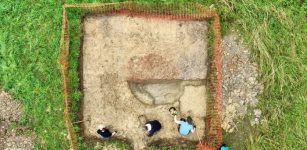Face Of Man From The Lost Medieval Village Of Dzwonowo Reconstructed Using 3D Printing Technology
Conny Waters - AncientPages.com - The face of a man who lived in the lost medieval village of Dzwonowo in Poland has been reconstructed using 3D printing technology.
We don’t know who the man was. Researchers suggest he may have been a merchant or craftsman. The discovery of his remains was exciting because the place where he lived was a settlement we know about only due to aerial photos and archaeological research.
His home was in the lost medieval village of Dzwonowo that was rediscovered some years ago.
The face of the man was reconstructed using 3D technology. Credit: Dzwonowo Zaginione miasto
The First News reports, “in January 2014, archaeologist Marcin Krzepkowski located the village by analyzing aerial photos and plant formations on the fields near Niedźwiedziny village in the Wielkopolska region, in western Poland.
Looking at the land from above, he saw the outlines of buildings and the urban structures. According to historic records, a town called Zwanowo (from the old Polish word for bell - zwan) or Dzwonowo should have been standing there, even if there were no traces of it above ground.
The first mentions of the settlement date back to the beginning of the 14th century, when the village belonged to the Poznań voivode (regional governor and military commander) Dobrogost - and then to his descendants.”
The man’s remains were discovered in the lost village of Dzwonowo, west Poland. Credit:
Following the astonishing discovery, archaeologists started to excavate the area and found remains of settlements that must have been inhabited by about 200 people. Old ruins of houses, a church, and a town square were examined. There was also a cemetery at the site where scientists discovered graves.
Krzepkowski, who leads the research and works in the Regional Wągrowiec Museum, said of the findings from the 14th to the 18th-century cemetery: “We examined over a hundred graves, which is an estimated five to ten percent of all burials at the Dzwonowo cemetery.”
The deceased were buried in even four to five layers, showing how long the graveyard was in use. One of the skeletons found during the excavations was of a 35 to a 44-year-old man.
The settlement was eventually located by analyzing aerial photos and plant formations. Credit:
His distinctive features, certain defects, and asymmetry, as well as the good condition of the skull, inspired the scientists to recreate his face.
Using clay, they sculpted the man’s features, focusing on the anterior bite and asymmetric eyes, nose, and ears.
The researchers estimate that the man from Dzwonowo lived between the beginning of the 14th and the second half of the 16th century.
Although researchers have no idea who the man was, they estimate that he was around 35-44 years old. Credit:
"Who was the deceased? I have no idea. We can only guess he was a merchant or a craftsman. He was almost certainly a resident of medieval Dzwonowo," said Krzepkowski.
Seeing his face is like going on a journey 500 years to the past.
Written by Conny Waters - AncientPages.com Staff Writer
























